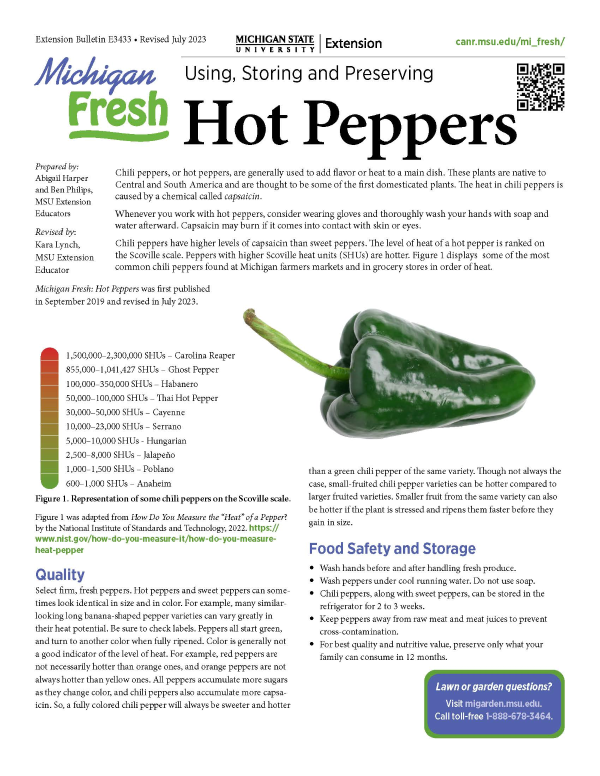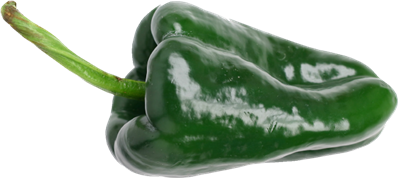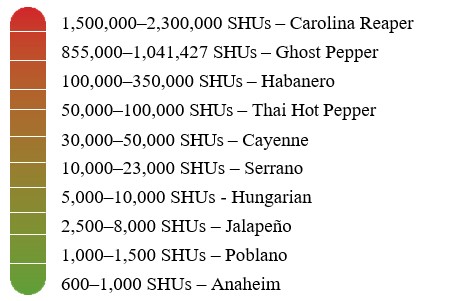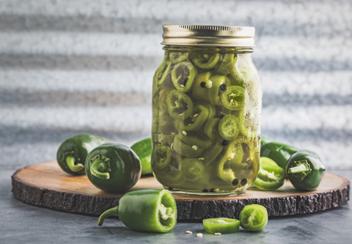
Michigan Fresh: Using, Storing, and Preserving Hot Peppers
DOWNLOADAugust 4, 2023 - Abigail Harper, Benjamin Phillips and Kara Lynch, Michigan State University Extension
This Document is offered in: English, Arabic Espanol,
Chili peppers, or hot peppers, are generally used to add flavor or heat to a main dish. These plants are native to Central and South America and are thought to be some of the first domesticated plants. The heat in chili peppers is caused by a chemical called capsaicin. 
Whenever you work with hot peppers, consider wearing gloves and thoroughly wash your hands with soap and water afterward. Capsaicin may burn if it comes into contact with skin or eyes.
Chili peppers have higher levels of capsaicin than sweet peppers. The level of heat of a hot pepper is ranked on the Scoville scale. Peppers with higher Scoville heat units (SHUs) are hotter. Figure 1 displays some of the most common chili peppers found at Michigan farmers markets and in grocery stores in order of heat.

Quality
Select firm, fresh peppers. Hot peppers and sweet peppers can some- times look identical in size and in color. For example, many similar- looking long banana-shaped pepper varieties can vary greatly in their heat potential. Be sure to check labels. Peppers all start green, and turn to another color when fully ripened. Color is generally not a good indicator of the level of heat. For example, red peppers are not necessarily hotter than orange ones, and orange peppers are not always hotter than yellow ones. All peppers accumulate more sugars as they change color, and chili peppers also accumulate more capsaicin. So, a fully colored chili pepper will always be sweeter and hotter than a green chili pepper of the same variety. Though not always the case, small-fruited chili pepper varieties can be hotter compared to larger fruited varieties. Smaller fruit from the same variety can also be hotter if the plant is stressed and ripens them faster before they gain in size.
Food Safety and Storage
- Wash hands before and after handling fresh produce.
- Wash peppers under cool running Do not use soap.
- Chili peppers, along with sweet peppers, can be stored in the refrigerator for 2 to 3 weeks.
- Keep peppers away from raw meat and meat juices to prevent cross-contamination.
- For best quality and nutritive value, preserve only what your family can consume in 12 months.
Preserving hot peppers
Hot pepper flakes
You can use a commercial dehydrator or an oven to dry chili peppers. Do batches of the same variety of peppers to make sure they dry consistently. Slice peppers in half and remove stems before placing in a single layer.
Leave seeds in for added heat, or remove for milder pepper flakes. If using an oven, preheat the oven to 200 °F and test frequently until all of the moisture is gone (moisture content is 10% or less), which can take 8 to 12 hours. Crush dried peppers in a food processor and store in spice jars.
Pickled hot peppers 
Pickled peppers can be water bath canned due to the acidity of vinegar in the recipe.
The following recipe from the National Center for Home Food Preservation combines hot and sweet peppers for a spicy pickled kick! Be sure to wear rubber gloves when handling hot peppers to avoid burning your skin or eyes.
Ingredients:
- 4 pounds hot peppers
- 3 pounds sweet red and green peppers, mixed
- 5 cups vinegar (5%)
- 1 cup water
- 4 teaspoons canning or pickling salt
- 2 tablespoons sugar
- 2 cloves garlic
To prepare: Leave small peppers whole or quarter and flatten large peppers. If preferred, remove pepper skins by blanching in boiling water or blistering in the oven, then peel. Stuff peppers into hot jars, leaving ½-inch headspace. Mix the vinegar, water, salt, sugar and garlic. Bring the solution to a boil and simmer for 10 minutes. Remove garlic and pour the hot solution over peppers in their jars, leaving ½-inch headspace. Remove air bubbles; adjust headspace if needed. Wipe jar rims with clean paper towel, adjust lids and process (see table that follows for recommended processing times).
|
Recommended process time (in minutes) for pickled hot peppers in a boiling-water canner. |
||||
|
|
Process time at altitudes of |
|||
|
Style of pack |
Jar size |
1 – 1,000 ft |
1,001 – 6,000 ft |
Above 6,000 ft |
|
Raw |
Half-pints or pints |
10 |
15 |
20 |
|
“Pickled Hot Peppers” recipe is adapted from the National Center for Home Food Preservation (NCHFP) recipe of the same name, reviewed February 2018 (https://nchfp.uga.edu/how/can_06/pickled_hot_peppers. html). The NCHFP adapted it from the Complete Guide to Home Canning (Agriculture Information Bulletin, No. 539), USDA, 2015. |
||||
Canning
Pressure canning is the only safe method of canning peppers that aren’t pickled. Peppers must be pressure canned to avoid the potential of the foodborne illness botulism. The instructions and processing times are the same for hot and sweet peppers. The National Center for Home Food Preservation suggests small peppers can be left whole or quartered to remove cores and seeds (2018b, February). Blanch in boiling water or blister skin with a broiler or stove top and cool by covering with a damp cloth. Peel skins and flatten whole peppers to fit more peppers per jar. Fill hot jars with boiling water and optional ½ teaspoon salt per pint, leaving 1-inch headspace. Remove air bubbles; adjust headspace if needed. Wipe jar rims with clean paper towel, adjust lids and process (see tables that follow for recommended processing times).
|
Recommended process time (in minutes) for peppers in a dial-gauge pressure canner. |
||||||
|
|
Canner pressure (PSI) at altitudes of |
|||||
|
Style of pack |
Jar size |
Process time |
0 – 2,000 ft |
2,001 – 4,000 ft |
4,001 – 6,000 ft |
6,001 – 8,000 ft |
|
Hot |
Half-pints or pints |
35 |
11 lb. |
12 lb. |
13 lb. |
14 lb. |
|
Recommended process time (in minutes) for peppers in a weighted-gauge pressure canner. |
||||
|
|
Canner pressure (PSI) at altitudes of |
|||
|
Style of pack |
Jar size |
Process time |
0 – 1,000 ft |
Above 1,000 ft |
|
Hot |
Half-pints or pints |
35 |
10 lb. |
15 lb. |
Let jars stand undisturbed for 12 to 24 hours, remove rings, check to make sure lids are sealed, wash jars, label, date and store. Food in jars that do not seal must be reprocessed in a clean jar with a new lid within 24 hours, refrigerated or frozen.
Tables were adapted from the National Center for Home Food Preservation (NCHFP), Selecting, Preparing and Canning Vegetables: Peppers, reviewed Feb- ruary 2018 (https://nchfp.uga.edu/how/can_04/peppers.html). The NCHFP adapted them from the Complete Guide to Home Canning (Agriculture Information Bulletin, No. 539). USDA, 2015.
Freezing
Wash peppers and remove the stem. Freeze smaller varieties whole, or slice in half and remove seeds for a milder flavor. You can freeze peppers on a cookie sheet individually and then place into plastic freezer bags to prevent sticking. Seal, label, date and freeze.
Resources
- Cantwell, M. (2009, February). Vegetables produce facts English. Uni- versity of California Postharvest Center.
- Hill, M., & Kendall, P. (2012, August). Making pickled peppers at home (Rev. ed.). Colorado State University Extension. https://extension. colostate.edu/topic-areas/nutrition-food-safety-health/making- pickled-peppers-at-home-9-314/
- Michigan State University Extension. (2022). How much should I buy? A guide to fresh fruits and vegetables for home cooking. https:// www.canr.msu.edu/resources/how_much_should_i_buy
- U.S. Department of Agriculture. (2018, April). Peppers, hot chili, red, raw. FoodData Central Search Results. https://fdc.nal.usda.gov/ fdc-app.html#/food-details/170106/nutrients
- University of New Hampshire Cooperative Extension. (2019, March 13). What is the best way to start growing my own hot peppers? https://extension.unh.edu/blog/what-best-way-start-growing- my-own-hot-peppers
- Whitlock, L. (2016, May 31). How to grow peppers. Michigan State University Extension. https://www.canr.msu.edu/uploads/resourc- es/pdfs/peppers.pdf
References
- National Center for Home Food Preservation. (2018a, February). Preparing and canning pickled vegetables: Pickled hot peppers. https://nchfp.uga.edu/how/can_06/pickled_hot_peppers.html
- National Center for Home Food Preservation. (2018b, February). Selecting, preparing and canning vegetables: Peppers. https://nchfp. uga.edu/how/can_04/peppers.html
- National Institute of Standards and Technology. (2022, June 27). How do you measure the “heat” of a pepper? https://www.nist.gov/ how-do-you-measure-it/how-do-you-measure-heat-pepper
More information



 Print
Print Email
Email






